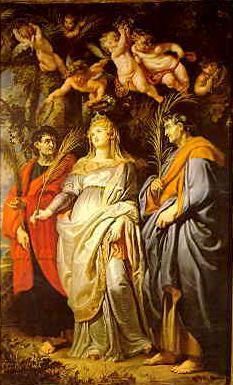Feast 12 May | Name Nereus, Domitilla, | |
 | ||
Died Rome (Nereus and Achilleus); Terracina (Nereus, Achilleus and Domitilla, according to legend); Rome (Pancras) Major shrine Santi Nereo e Achilleo; San Pancrazio | ||
Venerated in Roman Catholic Church | ||
Nereus, Achilleus, Domitilla, and Pancras are venerated as martyrs of the Roman Catholic Church.
Contents
In the present General Roman Calendar, revised in 1969, Saints Nereus and Achilleus (together) and Saint Pancras have distinct celebrations (optional memorials) on 12 May. Saint Domitilla is not included in the revised calendar, because the liturgical honours once paid to her "have no basis in tradition".
The Tridentine Calendar had on 12 May a joint feast (semidouble rank) of Nereus, Achilleus and Pancras. The name of Domitilla was added in 1595. The joint celebration of Nereus, Achilleus, Domitilla and Pancras continued with that ranking (see General Roman Calendar of 1954) until the revision of 1960, when it was reclassified as a third-class feast (see General Roman Calendar of 1960).
Nereus and Achilleus
The old Roman lists of the 5th century, which passed over into the Martyrologium Hieronymianum, contain the names of the two martyrs Nereus and Achilleus, whose grave was in the Catacomb of Domitilla on the Via Ardeatina. Nereus and Achilleus are also mentioned in the "Sacramentarium Gelasianum". The basilica of Sts. Nereus and Achilleus in the Via Ardeatina (not to be confused with the church of the same name near the Baths of Caracalla to which the relics of the saints were translated in the 6th century), was erected above the burial site of the two saints and is of the latter part of the 4th century; it is a three-naved basilica, which was abandoned in the mid 9th century and rediscovered in 1874 by de Rossi in the Catacomb of Domitilla. Amongst the numerous objects found in the ruins were two pillars which had supported the ciborium ornamented with sculptures representing the death of the two saints by decapitation. The acts of these martyrs, legendary even to a romantic degree, have no historical value for their life and death.
Legend
According to these legends, Nereus and Achilleus were eunuchs and chamberlains of Flavia Domitilla, a niece of the Emperor Domitian; with the Christian virgin, they had been banished to the island of Ponza (Pontia), and later on beheaded in Terracina. The graves of these two martyrs were on an estate of the Lady Domitilla near the Via Ardeatina, close to that of Saint Petronilla.
The author of this legend places the two saints quite differently from the poem of Pope Damasus: as Nereus and Achilleus were buried in a very ancient part of the catacomb of Domitilla, built as far back as the beginning of the 2nd century, we may conclude that they are among the most ancient martyrs of the Roman Church, and stand in very near relation to the Flavian family, of which Domitilla, the foundress of the catacomb, was a member. In the Epistle to the Romans, St. Paul mentions a Nereus with his sister, to whom he sends greetings (Romans 16:15); perhaps even the martyr was a descendant of this disciple of the Apostle of the Gentiles. Owing to the purely legendary character of these Acts, we cannot use them as an argument to aid in the controversy whether there were two Christians of the name of Domitilla in the family of the Christian Flavian, or only one: the wife of the Consul Titus Flavius Clemens. As to other martyrs of the name Nereus, who are especially noted in the old martyrologies as martyrs of the faith in Africa, or as being natives of that country (e.g., in the Martyrologium Hieronymianum, 11 May, 15 or 16 October, 16 November) though there is one of the name in the present Roman Martyrology under date of 16 October, nothing more is known.
The relics of Domitilla, Nereus and Achilleus are housed under the high altar of the church of Santi Nereo e Achilleo.
Domitilla
See Flavia Domitilla (saint).
Pancras
See Pancras of Rome
